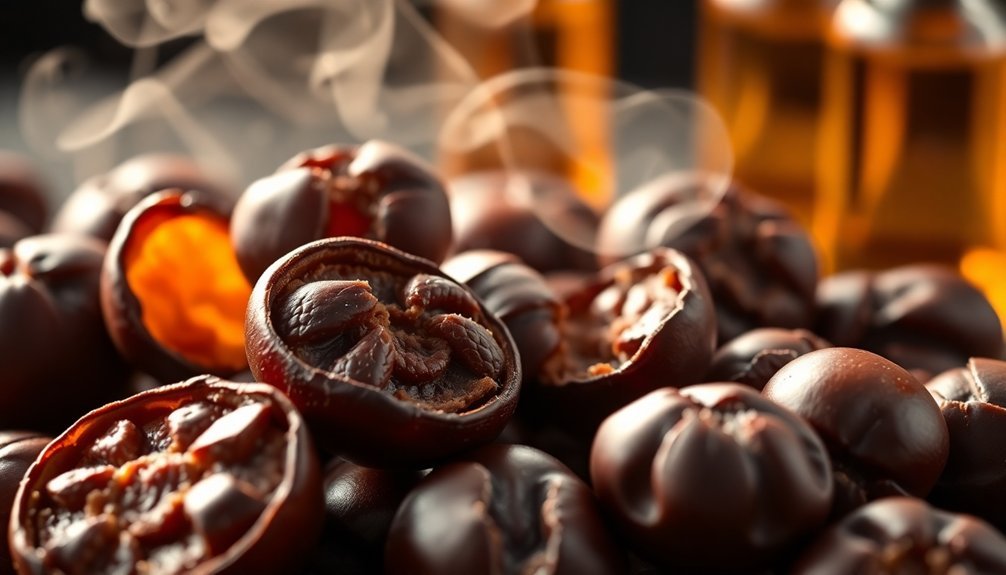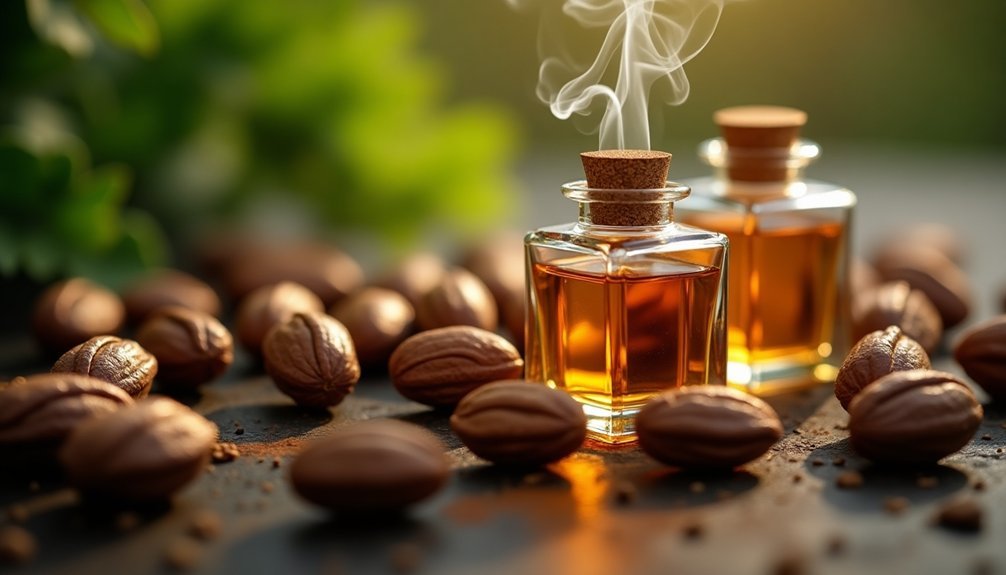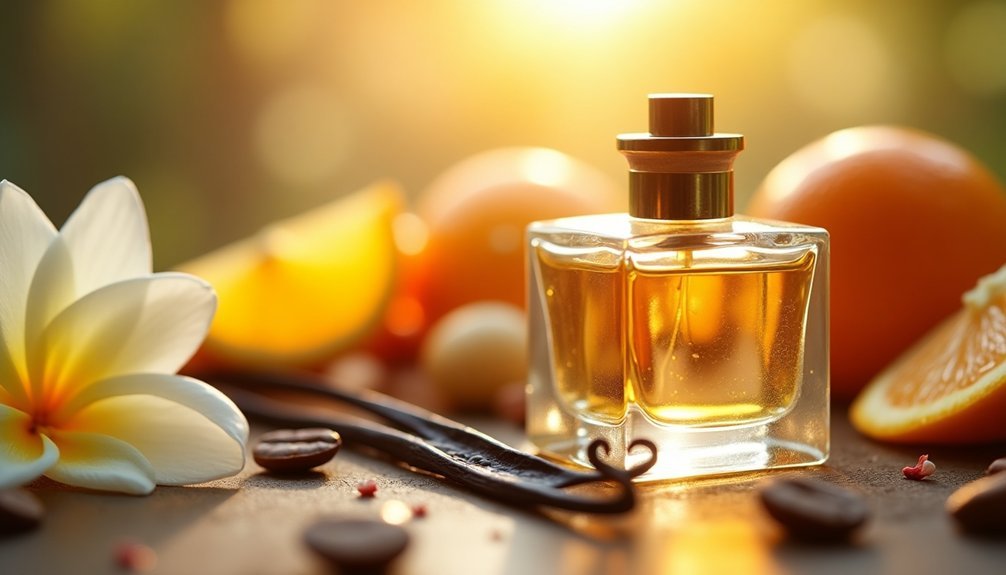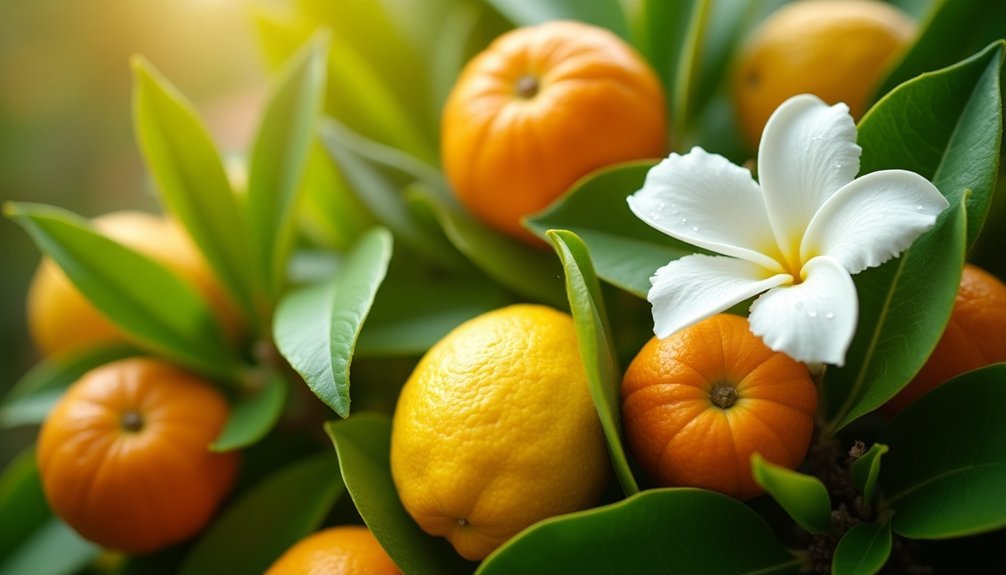Tonka bean's exceptional fixative properties will transform your perfumes into long-lasting masterpieces. You'll discover its warm, sweet almond-like aroma anchors volatile top notes while adding rich vanilla and caramel depth. When blending, start with a 1:3 ratio of tonka to essential oils, pairing it with florals like lavender or woods like cedarwood. Handle with care in a ventilated space, and you'll reveal the secrets to creating complex, enduring fragrances that maintain their character throughout wear.
The Rich Aromatic Profile of Tonka Bean

The tonka bean's enchanting aroma unfolds in multiple fascinating layers, from its signature sweet almond-like scent to deep smoky undertones.
You'll discover a complex symphony of vanilla-like warmth complemented by caramel sweetness and fresh hay notes.
What makes tonka bean truly special is its velvety soft texture in fragrance profiles, creating a rich, comforting presence that's hard to resist. The soaking in rum process enhances its deeply aromatic qualities.
You'll notice warm herbal nuances and gentle tobacco undertones that add depth to its character.
This remarkable ingredient serves as a versatile base note, bringing natural sweetness and nutty qualities that enhance both simple and complex fragrances.
Whether you're crafting a gourmand masterpiece or adding depth to a floral composition, tonka bean's multifaceted profile makes it an invaluable tool in your perfumer's palette.
Extracting and Processing Tonka Bean for Perfumery
Modern perfumery employs three primary methods to extract tonka bean's precious aromatic compounds, with solvent extraction being the most widely used technique.
You'll find that solvents like ethanol and acetone effectively draw out key components like coumarin and vanillin. While steam distillation captures a lighter version of tonka's aroma, CO2 extraction offers the purest and most concentrated result.
Before extraction begins, you'll need properly processed beans. The raw materials undergo a careful preparation: after harvest, they're dried for a year, cleaned, and sometimes soaked in alcohol to enhance coumarin crystal formation.
The beans are then ground to increase surface area for ideal extraction. This essential process helps achieve a rich, balsamic warmth that defines tonka's signature character in perfumes. During processing, you'll want to maintain strict temperature control and use a material-to-solvent ratio of 1:4 to 1:5 for the best results.
Blending Tonka Bean With Other Essential Oils

You'll find Tonka bean blends exceptionally well with florals like lavender and jasmine, woody oils like cedarwood and fir, and spicy aromatics like black pepper and cinnamon.
When creating therapeutic blends, start with a 1:3 ratio of Tonka bean to your chosen essential oil, adjusting gradually to achieve your desired fragrance profile.
For a balanced composition, pair Tonka bean with floral top notes, woody middle notes, or spicy base notes to create depth while maintaining harmony in your blend.
Always perform a patch test first before applying any new essential oil blend topically to ensure you don't experience any adverse reactions.
Recommended Essential Oil Pairings
Successful Tonka bean fragrances rely heavily on complementary essential oil pairings that enhance its warm, sweet, and complex profile.
When creating your blends, you'll find that Tonka bean pairs exceptionally well with both floral and woody notes, creating depth and sophistication in your perfumes.
- Combine Tonka bean with florals like lavender, jasmine, or geranium to create a balanced, sweet aroma that's perfect for daytime wear.
- Add woody notes such as cedarwood, sandalwood, or vetiver to ground your blend and create an earthy, forest-like depth.
- Explore gourmand combinations using vanilla, cinnamon bark, or tobacco to enhance Tonka bean's natural caramel-like qualities.
For oriental-style fragrances, you can't go wrong pairing Tonka bean with amber or heliotropine, which amplify its sweet, powdery characteristics.
Best Therapeutic Blending Ratios
Creating therapeutic blends with tonka bean requires precise measurements and careful attention to ratios.
Start with 2 milliliters of tonka bean tincture as your base, then add complementary essential oils in small quantities. You'll find success with a blend of 2ml tonka tincture plus 4 drops rose, 1 drop lavender, 3 drops honeysuckle, and 2 drops myrrh.
To enhance your blend's longevity, incorporate natural fixatives like frankincense or vetiver. You can also add a small amount of carrier oil, such as jojoba or sweet almond, to slow evaporation.
If you're making a simple tonka perfume, mix 1 part tincture with 3 parts distilled water. Remember to use tonka bean sparingly, as it contains coumarin, which can be toxic in high concentrations.
Maximizing Tonka Bean's Fixative Properties
To maximize Tonka Bean Resinoid's exceptional fixative properties in your perfume formulations, you'll want to incorporate it into your base notes to anchor volatile top notes effectively.
You can rely on Tonka Bean's stabilizing power to extend your fragrance's life span, ensuring the scent maintains its character and intensity throughout its wear time.
When working with complex compositions, you'll find Tonka Bean particularly valuable for balancing multiple fragrance elements while providing a sturdy foundation that allows each note to unfold gracefully.
Stabilizing Volatile Top Notes
While many perfumers prize tonka bean for its distinctive aroma, its role as a fixative makes it invaluable for stabilizing volatile top notes in fragrances.
When you're working with flighty top notes like citrus or light florals, tonka bean's coumarin content acts as an anchor, helping to extend their presence in your composition.
- Coumarin molecules bind with volatile compounds, slowing their evaporation rate and maintaining the fragrance's initial impact.
- You'll find tonka bean particularly effective when paired with bergamot, lavender, and other aromatic compounds that tend to dissipate quickly.
- It creates a smooth connection between top and middle notes while adding warmth and depth to your composition.
This natural fixative works especially well in chypres and fougères, where it helps maintain the integrity of complex note structures.
Extending Fragrance Life Span
Perfumers who want to maximize their fragrance's longevity will find tonka bean resinoid to be an essential ally. You'll discover that its powerful fixative properties help anchor volatile top and middle notes, ensuring your fragrance maintains its character throughout wear. The coumarin component acts as a stabilizing force, preventing rapid scent deterioration while allowing the fragrance to evolve naturally.
| Feature | Benefit | Application |
|---|---|---|
| Fixative Power | Anchors volatile notes | Base layer |
| Coumarin Content | Stabilizes scent profile | Middle notes |
| Sweet Warmth | Balances composition | Throughout |
| Blending Ability | Enhances other notes | All layers |
The resinoid's versatility shines when you combine it with other ingredients like lavender, amber, or woody notes, creating complex fragrances that retain their strength and character for extended periods.
Balancing Complex Scent Profiles
Since tonka bean possesses both sweet and spicy characteristics, it serves as a masterful balancing agent in complex fragrance compositions.
You'll find it's particularly effective when you need to harmonize contrasting elements in your perfume creations. By incorporating tonka bean, you can achieve sophisticated blends that maintain their integrity throughout the fragrance's evolution.
- Sweet-Spicy Balance: Combine tonka bean with floral or fruity notes to add warmth and depth while preventing overwhelming sharpness.
- Oriental Enhancement: Use it to create rich, sophisticated bases in oriental fragrances by pairing with cedarwood or sandalwood.
- Fixative Power: Leverage tonka bean's ability to anchor volatile top and middle notes, ensuring your fragrance develops gradually and maintains its intended character.
Creating Long-Lasting Perfumes With Tonka Bean

Thanks to its exceptional fixative properties, tonka bean serves as a master key in creating long-lasting perfumes that stand the test of time.
When you're formulating a fragrance, you'll find that tonka bean resinoid expertly anchors volatile top and middle notes, allowing your scent to evolve gradually throughout the day.
You can maximize tonka bean's fixative power by pairing it with complementary notes like lavender, clary sage, and bergamot.
It's particularly effective in chypres, fougères, and oriental bases, where it helps stabilize both floral and fruity accords.
The coumarin molecule in tonka bean doesn't just contribute to its signature warm, sweet aroma – it's also responsible for its impressive staying power.
Safety Guidelines and Storage Tips for Tonka Bean Use
While tonka bean adds alluring depth to fragrances, proper safety measures remain essential when working with this potent ingredient. You'll need to handle tonka bean absolute with caution, ensuring you're working in a well-ventilated area and wearing protective gloves to prevent skin contact.
- Never ingest tonka bean absolute or smoke while handling it – if accidental ingestion occurs, don't induce vomiting but seek medical help immediately.
- Store your tonka bean absolute in a tightly sealed container away from heat sources, moisture, and direct light to maintain its quality.
- Keep the safety data sheet handy and Chemtrec's emergency number (1-800-424-9300) readily available in case of accidents.
If you experience skin irritation or an allergic reaction, wash the affected area thoroughly with soap and water, and consult a physician if symptoms persist.
Frequently Asked Questions
Can Tonka Bean Trigger Vanilla Allergies in Perfume Wearers?
No, tonka bean won't trigger your vanilla allergies since they contain different compounds. You should watch for coumarin sensitivity instead, as that's the allergenic compound in tonka bean that's distinct from vanilla's vanillin.
How Does Temperature Affect Tonka Bean's Fixative Properties During Storage?
You'll find that high temperatures degrade tonka bean's fixative properties. Keep them below 25°C (77°F) to maintain stability. Heat accelerates oxidation, weakening the coumarin compounds that make tonka an effective fixative.
Why Is Tonka Bean More Expensive Than Similar Aromatic Ingredients?
You'll find tonka beans costly due to their extreme rarity – each tree produces just one bean. They're also labor-intensive to harvest, require complex processing, and face strict regulations that limit their availability.
Does Synthetic Tonka Bean Provide the Same Fixative Benefits as Natural?
No, you won't get the same fixative benefits from synthetic tonka bean. It lacks the complex natural compounds found in tonka bean absolute that help anchor volatile notes and extend fragrance longevity in perfumes.
Can Tonka Bean's Scent Change When Combined With Specific Skin Chemistry?
While your skin chemistry can affect fragrances, tonka bean's fixative properties actually help maintain a consistent scent profile. You'll notice it blends well with your natural oils while keeping its sweet, warm character.
In Summary
You'll find tonka bean to be an invaluable addition to your perfumery toolkit. Its rich vanilla-like aroma and powerful fixative properties help create longer-lasting fragrances that maintain their integrity. When you blend it carefully with other essential oils and follow proper safety guidelines, you'll reveal its full potential. Store your tonka bean products properly, and you'll always have this aromatic gem ready for your next perfume creation.





Leave a Reply